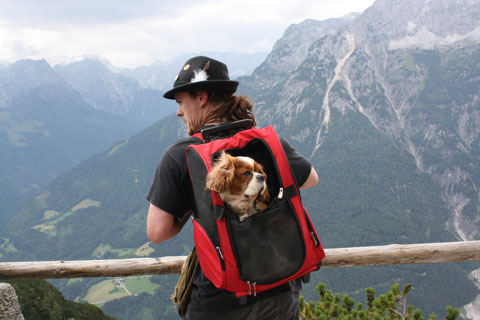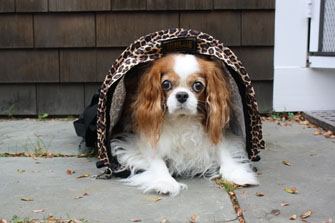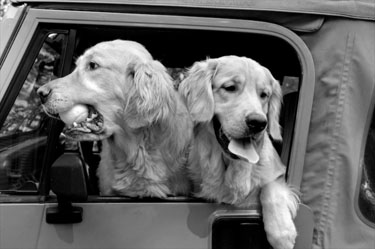Traveling With Your Dog:
What You Need to Know
By the Editors of Farewell Travels

Thinking about taking your dog on vacation? You’re not alone. Increasingly, travelers are choosing destinations that they can visit with their furry companions. And to meet this need, hotels, resorts and other accommodations are offering all sorts of welcoming goodies.
But before you go making any reservations, take the time to really think about whether it’s a good idea. Simply put…not all dogs are cut out to be travelers. Like children, they’re all different. Some are troopers, others are easily stressed. It’s important to put your dog’s comfort and safety above your own needs when taking them on trips. Chances are you’ve got the basics covered--always travel with water, pack any medications your dog requires, never leave a dog in a car with windows closed--but here are some other tips to help make your trips go smoothly.
Flying with Small Dogs
• Call the airline you are planning to fly. The FAA (Federal Aviation Administration) allows each airline to establish its own policies and procedures. In general though, when you bring a dog into the cabin, it is considered carry-on baggage and you must follow the carry-on baggage rules. Clear this before booking your tickets.
• Book your seat and your dog at the same time. There will be a charge for your dog, which varies from airline to airline. Under no circumstances should you just show up with your dog. You risk being turned away from the flight.

• Pack your dog's health documents. Your safest bet is to have a health certificate that is dated within 10 days of your trip. If you are traveling internationally, find out if you need a Pet Passport (a good vet should be able to steer you in the right direction).
• Choose the right pet carrier. Flexible pet carriers are what many breeders and show-dog owners use when traveling. They work well on planes because you can push them down a bit with your dog inside to fit under the seat in front of you. They don't fold in, cramming the dog, and they bounce back once you take them out from under. Sturdi Products makes a variety of bags for dogs and cats--like this one pictured above--which you can learn more about here.
• Avoid giving your dog any sort of sedative. It’s very simple; if your dog needs to be sedated, he or she should probably not be flying.
• Give your dog a little exercise before you board. Once you’ve checked in and gone through security, walk your dog on a leash in the airport. Keep in mind that all airports are different. Some will allow this, others will tell you to put the dog back in the bag. Play by their rules.
• Pack plenty of paper towels. Stuff them in the pockets of the carrier, just in case of accidents. You never know.
• On the plane, don’t take your dog out of the bag. He or she won’t want to go back in. Dogs can be very comfortable and feel safe in carriers.
• Take along a small water bowl and bottle. While you don't want your dog drinking a lot before or during the trip, it's important to have a bit of water and use it sparingly. Sometimes the cabin can be very hot and dry. Once you've gone through security, fill the bottle with water.
Road Trips
• Avoid food right before and after the trip. Best to give your dog a meal several hours before traveling by car and once you get to your destination, wait  for his/her stomach to settle down before feeding. for his/her stomach to settle down before feeding.
• Take your dog for a long walk just prior to leaving. That way your dog will be more likely to settle down and rest in the car.
• Create a comfortable and safe traveling spot for your dog. Consider taking along a familiar dog bed or blanket so your dog feels at home and set it up so he/she can see out the window. Also, use a safety restraint which is similar to regular seat belts but made for dogs (available in most pet stores). Seat your dog within your reach so you (or a family member) can pet him/her periodically.
• Take breaks every 2-3 hours. Plan to stop at rest areas along the way, allowing your dog to stretch his/her legs.
When You Can't Take Your Dog(s) With You
As happy as you might be traveling with your dog, sometimes it just can't work. That being the case, here are some important considerations for leaving your dog while you're away.
• Think twice about leaving your dog with Grand ma or Aunt Nancy. While she has willingly volunteered to dog-sit, sometimes dogs can feel out of sorts when not in their usual surroundings and without you. A scared dog might dart out an open door and get hit by a car or lost. ma or Aunt Nancy. While she has willingly volunteered to dog-sit, sometimes dogs can feel out of sorts when not in their usual surroundings and without you. A scared dog might dart out an open door and get hit by a car or lost.
• Take the time to find a good boarding kennel. Visit them, interview the owners. It’s important that your dog is always safe and feels secure.
• Avoid hiring a dog sitter who doesn't stay at your home. Don’t be tempted to have someone just check in on your dog a couple of times a day. Dogs can get lonely. It’s too long to be alone.
• Make sure your dog can't get into trouble. If you are boarding a dog in a place that allows dogs free roaming, don’t allow them to let your dog loose when no one is home.
Happy travels!
Photo Credits: Dog in backpack taken in Austrian Alps by Susan Farewell; dog in pet carrier is our resident model, Lily; black-and-white photographs were taken by Pamela Einarsen, who also shares her photo tips on taking family vacations here.
|

